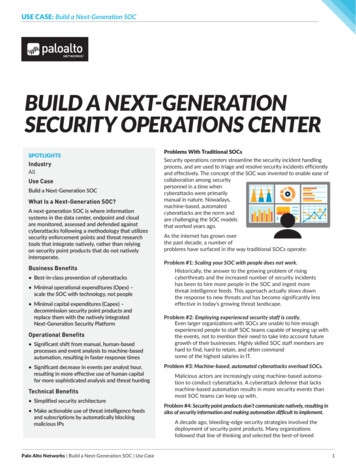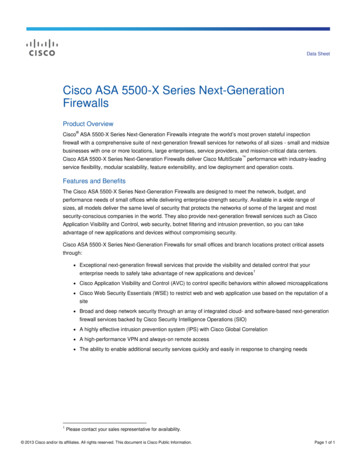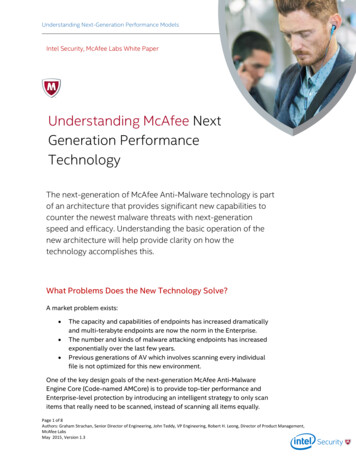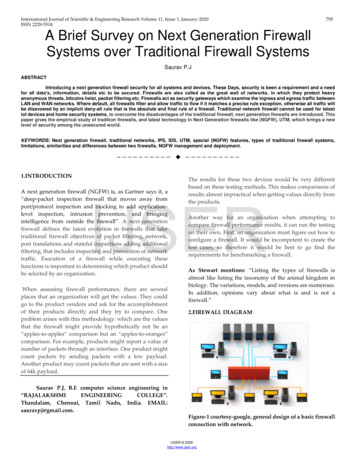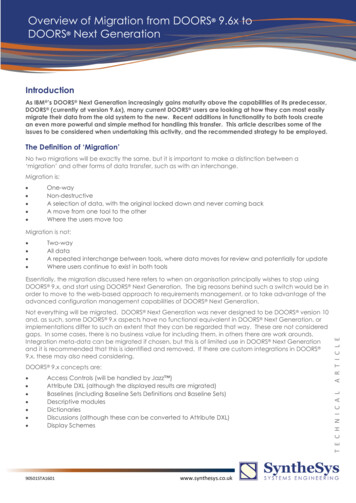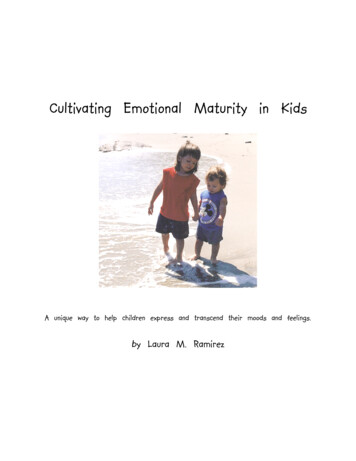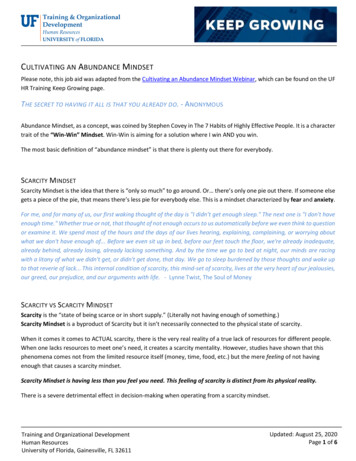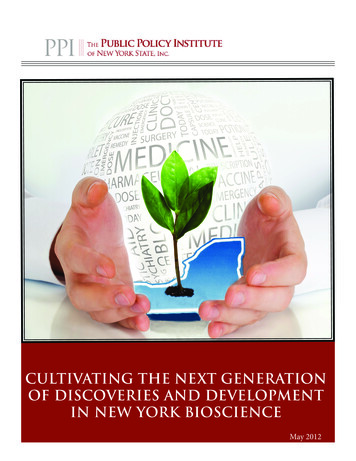
Transcription
CULTIVATING THE NEXT GENERATIONOF DISCOVERIES AND DEVELOPMENTIN NEW YORK BIOSCIENCEMay 2012
Cultivating the Next Generation of Discoveries and Developmentin New York BioscienceMay 2012Table of ContentsSectionI.II.III.IV.V.VI.VII.TitleExecutive SummaryOvercoming the BarriersBasic building blocks: Vision and peopleTying discoveries to economic development:Expanding the metricThe State as a Catalyst - “The Ask”A Governor’s Council: Bridging thecommunication gap and marketing New YorkbioscienceDedicated funding for the bioscience industryCreating affordable office space for start-upsConclusionCompany OverviewsBibliographyGlossary of AcronymsPage34471212141618192931This report is produced byThe Public Policy Institute of New York State, Inc.President: Heather C. Briccetti, Esq.Author: Peg Zokowski, Principal at Innovators Ink, LLCProduction Editor: Sonia LindellContributing Editors: Ken Pokalsky, Rob Lillpopp, Bill Stroh, Sonia LindellCopy Editor: Anna M. DeLisleMay 2012The Public Policy Institute of New York State, Inc. 518/465-7511 www.ppinys.org2
Cultivating the Next Generation of Discoveries and Developmentin New York BioscienceMay 2012“We have all of the essential elements of an innovativeecosystem but it is going to take time to integrate to a pointwhere we can truly call ourselves a high tech community.”–Theresa Mazzullo, CEO, Excell Partners“Startups give you a shot at growing up companies in yourown state.”–Derek Brand, director of business development, EnumeralBiomedical Corp.Executive SummaryNew York’s bioscience industry currentlysupports 250,000 jobs — both direct andindirect — generating 309 million inpersonal state income tax and over 5.63 billionin wages. Its R&D attracts significant federalfunding and is consistently within the top threestates in terms of National Institutes of Health(NIH) research awards. In 2010 alone, NewYork received 562.8 million from the Centersfor Disease Control, 32.8 million from theAgency for Healthcare Research & Quality, 4.5billion from the NIH and 491.9 million from theNational Science Foundation (NSF). Arguably,it should be considered one of the state’s topinnovation industries.While New York is just one of several playersalong the bioscience continuum, it has thecapacity to strengthen or hinder company andindustry growth at several points along thatcontinuum. In his 2012 State of the StateAddress, Governor Cuomo asked, “How doesgovernment spur job creation in a down economywhile limiting spending and maintaining fiscaldiscipline?” The answer, he said, is in “creativepublic-private partnerships that leverage stateresources.” In this report, increased coordinationbetween public policy and private investments —in effect, public-private partnerships — is shownas a critical component of the state’s strategy topromote growth in the bioscience sector.Many interviewed for this report agreed thatNew York has all the “piece parts” of a dynamicbioscience industry, but lacks some of thecoordination and support it needs reap thebenefits and become more competitive nationallyand globally. A better defined vision and modelwill provide the direction and coordinationneeded to mobilize the piece parts within aframework that is both specific to the state andconducive to promoting organic cluster growth.Of particular importance to a majority of thoseinterviewed was the need for the state andLegislature to understand the industry in full— from lab to market — when drafting andimplementing policy. There are, on average, 10 to20 years in between those endpoints encompassingcompanies of varying sizes with specific needs,multiple pre-clinical and clinical trials, myriadregulatory and policy demands from both federaland state agencies, and investors from angel toventure capital (VC). Each stage between lab andmarket carries its own set of technical challenges,funding needs, and regulatory requirements. And apotential domino effect is created when these andother outside influences — e.g., health insurancepolicies, industry trends, regulatory requirements— are introduced or withdrawn.Startups and early stage companies are theindustry’s nexus between the university lab andthe larger market. As such, this report is centeredaround the experiences of startup, early stage andmid-size bioscience companies with a presencein New York. Based on interviews with 30 CEOs,entrepreneurs, investors, academic institutionsand state agencies, as well as anchor and largebioscience companies across the state, anddrawing upon previous research, the Public PolicyInstitute (PPI) has identified three specific policyand program initiatives to create public-privatepartnerships for its bioscience industry. Theyinclude: Establishing a Governor’s Council to focusthe state’s biopharma vision and increasecommunication and understanding betweenthe state and industry, as well as developinga proactive marketing campaign directed atinternal and external audiences that championNew York’s bioscience industry and the benefitsof doing business here. Designating financial resources specificallyfor bioscience companies. In particular,establishing a matching grant program forbioscience companies awarded Small BusinessInnovation Research (SBIR) grants, andenacting a bill to create a dedicated BiosciencesCommercialization Assistance Fund.3The Public Policy Institute of New York State, Inc. 518/465-7511 www.ppinys.org
Cultivating the Next Generation of Discoveries and Developmentin New York BioscienceMay 2012 Increasing the amount of affordable incubator and lab space forstartups and early-stage companies.This report is an opportunity to advance a better coordinated andconstructive dialogue among all the players who affect the forwardmovement of New York’s bioscience industry, and to hear directly from thevery companies — from startup to established — New York relies on togenerate jobs and revenue.Percent of bioscience industryclaimed by NAICS code3254.Pharma mfg (100%)541711.R&D in biotech (100%)541712.R&D in physical,engineering, and life sciences, exceptbiotech (33%)334516.Analytical lab instrumentmfg (30%)54138.Testing laboratories (30%)4242.Drug merchantwholesalers (10%)Overcoming the BarriersBasic building blocks: Vision and peopleNew York’s biopharma sector is lacking two critical basic buildingblocks at the state level for the three PPI recommendations tooccur: a clear vision by state officials and an entrepreneurial mindset.VisionThe lack of a clear vision hinders the development of people,infrastructure, and a strong continuum of company developmentneeded to keep New York competitive and to ensure its leadership in thebioscience industry. Without a shared vision to leverage its assets thestate will increasingly lose out to other states that have more focused andcoordinated approaches.622.Hospitals (4.5%)61131.Universities (1.9%)Source: New York BiotechnologyAssociationWithout a shared vision to leverage itsassets, the state will increasingly lose outto other states that have more focusedand coordinated approaches.As one biopharmaceutical senior executive pointed out, the message theyhear in New York is indifferent or confusing. “In the morning they areasking us what they can do to support us and keep us here, and in theafternoon they’re vilifying us.” In an article for Xconomy in August 2011,Ron Cohen, founder and CEO of Acorda, wrote that when he was chairmanof the New York Biotechnology Association (NYBA), he “got an earfulon high taxes and lack of vision in Albany.” According to the article, hecontinues to hear some of the same frustrations today as chairman of theThe Public Policy Institute of New York State, Inc. 518/465-7511 www.ppinys.org4
Cultivating the Next Generation of Discoveries and Developmentin New York BioscienceMay 2012emerging companies section of the BiotechnologyIndustry Organization (BIO). The lack of a sharedvision for the industry means that the state missesout on opportunities provided by the bioscienceindustry.Entrepreneurs and innovators drive theindustry, and the state needs to take an equallyentrepreneurial and determined approach to grow,attract and retain bioscience companies.An entrepreneur starts with a vision, and thecompany he/she forms develops a business planfor its potential investors. Similarly, the state needsto develop its vision and plan for the bioscienceindustry.By example, the Massachusetts Life SciencesInitiative, a 1 billion, 10-year program tasked withrealizing Gov. Deval Patrick’s vision for the state’sbioscience industry, has a Five Point Plan “intendedto support the life sciences industry througheach stage of the development cycle. This workincludes making financial investments in public andprivate institutions growing life sciences research,development and commercialization as well asbuilding ties between sectors of the Massachusettslife sciences community.”As much as the state is asked to invest in thebioscience industry, the state also asks for thebioscience industry to invest in New York asa place to establish and maintain a presence.A clearly articulated vision from the state forthe bioscience industry would support bothinvestments.PeoplePeople are at the root of any technology hub.Even as a lack of clear vision hinders New York’sbioscience advance, it also contributes to anotherkey limiting factor: the availability of experiencedentrepreneurs needed to move the industryforward. “The importance of management cannotbe underestimated,” noted Theresa Mazzullo,CEO of Excell Partners. “This is especially truein biotech. There is no substitute for a serialentrepreneur, one who has been there, donethat before. Absent that, the individual whounderstands the technology, the market andthe long path to glory is critical for a life sciencestartup. Finding the right talent to wrap around atechnology is an ongoing challenge in the upstateregion, particularly in the life science area.”According to a survey of CEOs included in the2012 California Biomedical Industry Report,the top reasons why CEOs decided to stay inCalifornia and/or expand their operations insideCalifornia were the “culture of entrepreneurship orinnovation” and “skilled workforce” in the state.The lack of experienced and serial entrepreneurswas of more concern among a majority of thoseinterviewed than was the issue of workforce,for both startups and established companies.Executives at Life Technologies — a Californiabased company with a manufacturing plantin Grand Island, New York — noted that theyhad much more difficulty attracting seniormanagement, who had product and processknowledge, as well as international managementexperience. Attracting serial entrepreneur Dr.Allen Barnett to Kinex was “extremely importantand gave the company great credibility,” said LynDyster, a serial entrepreneur and vice-president ofresearch operations for Kinex.Shreefal Mehta, a serial entrepreneur with abackground in biomedical engineering and CEOof the Paper Battery Co., was asked to start abiotechnology executive education program at theLally School of Management and Technology atRensselaer Polytechnic Institute, but he “couldn’tpull in enough executives with experience inthe industry in order to attract the studentsand executives into the program.” The lack ofexperienced entrepreneurs creates an adversedomino effect: fewer entrepreneurs means fewermentors, fewer companies started, less revenuegeneration and less money directed back into thelocal community.Joe Scaduto, assistant director of businessdevelopment for the Center for Biotechnology atSUNY Stony Brook, said, “Linking technologistswith experienced entrepreneurs is a big issue,”and suggested establishing an Entrepreneur-InResidence (EIR) program that paid individuals withthe appropriate track record and domain expertisea salary for 12-18 months to identify and evaluatetechnologies with commercial potential, develop abusiness plan and investor presentation, negotiatea license agreement, and secure the first round of5The Public Policy Institute of New York State, Inc. 518/465-7511 www.ppinys.org
Cultivating the Next Generation of Discoveries and Developmentin New York BioscienceMay 2012funding. “It’s dedicated people that start and grow these companies. Inthe absence of an existing cadre of experienced entrepreneurs, we need toattract and focus them by reducing their risk.” Some academic institutionsand economic development agencies, such as SUNY and the New York CityEconomic Development Corporation, are also working to change this realityby establishing EIR programs.Derek Brand, director of business development for Enumeral BiomedicalCorp., noted that the overall ecosystem or entrepreneurial network is a “bitmore disparate and the bonds aren’t the same as in Boston.” So he starteda networking group that gathers monthly and focuses on attracting peopleinterested in early-stage companies and technologies. “It’s flourished sofar with an overall list of over 450 people and between 30-50 individualsattending each time.” Brand said he knows of at least two startupcompanies who have found CEOs through these interactions.Opportunity for a new modelThe lack of a comprehensive and coordinated vision can be seen inthe current shape of the bioscience industry in the state. One investorcommented, “New York should put a stake in the ground and thecommitment needs to come from the top.” In February 2009, TheArchstone Study noted that, of the nine biopharmaceutical regions in NewYork, “those with the highest number of facilities were New York City andLong Island with the best clustering [occurring on] Long Island, Rochesterand Westchester.”New York needs to develop a nuancedstrategy for maximizing the researchbased economic development potentialof our state’s nine individual bioscienceclusters.New York needs to develop a nuanced strategy for maximizing theresearch-based economic development potential of our state’s nineindividual bioscience clusters. We should not have all nine compete directlywith Boston’s and San Francisco’s well-established and very focused,integrated urban bioscience hubs on frontline research. New York has twoprimary hubs emerging - one in the Buffalo-Rochester region and the otherin a downstate corridor comprised of New York City, Westchester and LongIsland. Nathan Tinker, executive director of NYBA said, the state doesn’thave to look far for some great examples. “The Massachusetts Centerfor Biotech is focused, as is the state, on a 25 mile radius cluster. A bitfarther, North Carolina’s hub and spoke system is brilliant-a central hub inResearch Triangle Park and regional outposts to help grow it without beingeverything to everyone all the time.”The Public Policy Institute of New York State, Inc. 518/465-7511 www.ppinys.org6
Cultivating the Next Generation of Discoveries and Developmentin New York BioscienceMay 2012Cohen is adamant that someone needs to “squarethe circle” on the regional fiefdoms. “We needa vision that is honest and straightforward soupstate and downstate aren’t competing to be thebioscience hub for New York. Instead of competingfor the same activity, we need to look at therelative strengths of each region and leverage thecompetitive advantages And we need visionaryleaders with strength, skill and influence to makethe vision a reality.” This sentiment was echoed byothers.One model presented could help to better leveragedownstate’s considerable R&D generation, patientpopulation, entrepreneur concentration, andcapacity to house post-incubator companies inWestchester County as the potential anchor forNew York’s bioscience industry. At the sametime upstate, with its access to universities,available and educated workforce, lower cost ofliving, less expensive land and physical spacecould address the manufacturing needs of thebioscience industry. “There’s a huge demand forthem. New York doesn’t have them in high enoughconcentration. We need a plan to attract companiesand the industry to upstate,” Cohen noted.Upstate’s smaller bioscience clusters which have anexus point between vital academic health basedresearch and existing clinical trial networks, aswell as the combination of cheap land, predictableand comparatively affordable power and abundantwater resources, can become a magnet foremerging manufacturing based enterprises both forbiotech startups bursting at the seams of existingincubators and more traditional big pharmamanufacturing. In short, the regional triangleconnecting the Syracuse, Binghamton and Albanyclusters can become manufacturing magnets thatcan be more attractive on cost, than the Bostonand San Francisco market. The goal should behaving each of New York’s nine bioscience clusterscompete from positions of strength.New York needs to cross market its strengthsacross the length and breadth of our state to endthe de facto silo marketing which undervaluesupstate’s bioscience clusters, particularly on thetranslational research to manufacturing side ofthe equation. Silo based regional marketing stuntsour state’s potential for synergistic success acrossregions. Only a statewide effort can institute astrategic plan where New York’s clusters treat eachother as tomorrow’s de facto partners rather thantoday’s direct competitors.Doing so could better position New York Stateto compete in this global industry not only withCalifornia, Massachusetts, New Jersey, and NorthCarolina, but also with Canada, Singapore, India,China, and Germany, among others.Barry Kappel, vice president of businessdevelopment at ContraFect Corporation, seesWestchester as a good place to support a smallcompany. “Our build out cost half of what it wouldhave in New York City. We’re only 25 minutes bytrain to downtown Manhattan for weekly meetingswith Rockefeller University and Mt. Sinai, haveno problem attracting talent, and have accessto the intellectual capital in New York City.” Themanufacturing process, on the other end, is thehigh value-added component of the bioscienceindustry because companies must identify andexplain their manufacturing process prior toreceiving FDA approval for New Drug Investigationwhich involves human testing. Workforcedevelopment, salaries, and tax incentives nowbecome critically important issues for the companyat this stage, explained Steven Casper, associateprofessor at Keck Graduate Institute in Claremont,California.In its May 2011 report, New York Must Step Up It’sGame, PPI estimated the manufacturing multiplieradvantage. Using models from the Bureau ofEconomic Analysis, the study determined that“the jobs multiplier for cutting-edge biotechnologyand nanotechnology firms is 9.2. This means thatfor every job in these firms about ten additionaljobs are supported.” The study also noted thatmanufacturers “lock in the academic-commercialnexus through participation in university affiliatedresearch parks.”Tying discoveries to economic development:Expanding the metricAs noted above, the connection between scientistsand entrepreneurs is an important nexus for thebioscience industry. Moving the science from ideato product, particularly for early stage companies,requires the vital interaction of universities, whichhouse research and scientists, and companies,which commercialize the products. In New York,the requirements for successful interactions are notalways known or met. Optimizing the links between7The Public Policy Institute of New York State, Inc. 518/465-7511 www.ppinys.org
Cultivating the Next Generation of Discoveries and Developmentin New York BioscienceMay 2012universities and the bioscience industry is, therefore, vital for the development of the industry in New York.University technology transfer offices (TTOs) play an important role ininfluencing the path forward for startups formed around commerciallyviable and promising discoveries. Given this role, a number of thoseinterviewed agreed the traditional set of benchmarks used to measuresuccessful tech transfer should be updated to include, or even focuson, economic development and advancing the startup. Tom Fitzgerald,president & chief operations officer of OyaGen, noted that, “Techtransfer offices are not currently viewed as a cornerstone for economicdevelopment. Small companies require more individualized attentionwhere IP and capital are concerned. The latter is put into place as you go,whereas in a large company all of this is already established.” StephenCurry, CEO of ADispell, a two-year-old company out of Cornell, saiduniversities should be looking to generate the next generation of royaltiesstream.Typical drug discovery & development timelineDiscovery2 - 5 yearsPreclinical development1 - 3 yearsBasic research, screendesign, screening,hit analysis, leadoptimizationScale-up, toxicology,pharmacokinetics,formulation, clinicaltrial design, animalmodelsClinical trials4 - 7 yearsISafety, dosingFDA2 yearsIIIIISmall scaleefficacyLarge scaleefficacyRx9 - 16 years“Valley of Death”Gap funding necessary to bridge pathfrom patent to licensingIt takes up to 10 years and between 200,000 - 500,000 to commercialize a diagnostic tool or device; on average between 10-20 years and 500 million - 1 billion for a drug. Of the thousands of compounds screened annually, roughly 250 enter preclinical testing.Of those, roughly 5 make it to human trials and 1-2 on average will be approved by the FDA.Source: Based on data from PhRMA, Excell Partners and several individuals who were interviewed for this reportThe TTOs typically have an operational budget and a limited patentbudget, but generally require startups to reimburse them up front forcosts associated with obtaining patents and licenses. These costs canrun upwards of 150,000 in the first 18 months and exclude the cost ofprototype development and reducing the invention to practice. Spinningout companies from universities in this manner sets up a situation that cansignificantly hinder a startup’s potential success or even prevent companyThe Public Policy Institute of New York State, Inc. 518/465-7511 www.ppinys.org8
Cultivating the Next Generation of Discoveries and Developmentin New York BioscienceMay 2012formation around a promising discovery. Even if astartup were well capitalized enough to pay thesecosts, it doesn’t necessarily mean it owns theIP — the university retains those rights in manyinstances.Then there is the additional cost to startups toretain their own counsel to negotiate the licenseand payments going forward to the attorneyprosecuting the patent, as well as patent foreignfilings and prosecutions in the major globalmarkets — EU, Japan, Canada and possiblyAustralia, China and India.According to some interviewed for this report,universities are also assigning unrealisticcommercial value to discoveries, which oftenresults in a potential corporate partner or licenseewalking away and the technology or discovery“dying on the grapevine.” One serial entrepreneurrecommended restructuring TTOs with officerscapable of evaluating a discovery both forcommercial viability and realistic commercial value,if not standard practice already.Despite this, there are some universities activelyworking to change how they interact with startups.In his position as vice provost at the Universityof Buffalo’s Office of Science, Technology Transferand Economic Outreach, Dr. Robert Genco hasbuilt a new process and philosophy in place ofthe old model. “We think it’s incumbent uponthe university to take these discoveries andcommercialize them for the benefit of society,” hesaid. “This is our mission. If you accept federalresearch dollars, you just can’t publish thediscovery. It also has to benefit society.”In 2011, SUNY voluntarily joined the federalScience and Technology for America’sReinvestment Metric Initiative (STAR) — whichquantifies the influence of federally fundedresearch on the number of jobs created and themultipliers that come out of those jobs. ClarksonUniversity also incorporated economic developmentindicators such as tracking the number ofstartups established with traditional technologytransfer measures. And the Rochester Instituteof Technology reinvented its own incubator —now called Venture Creations — with the expresspurpose of translating academic research intocommercially viable and technologically innovativebusinesses.With respect to the upfront costs assumedby TTOs, several alternative solutions wereproposed by both entrepreneurs and academicadministrators, including: A low-interest loan fund to pay upfront costs; Scheduling payouts over time; Downstream royalties; Convertible debt; or An equity stake in the company.Because clinical research is conducted in theuniversities and hospitals where patients are seenby doctors, the university-industry connectionis both inherent and essential. And the currentindustry environment is driving how largepharmaceuticals work with universities and TTOs.Companies like Pfizer are “trying out” a newbusiness collaboration, or shared partnership, thatleverages each partner’s strengths. In 2011, Pfizerlaunched the Centers for Therapeutic Innovation(CTI) to speed up translation of academic ideasinto drugs, address differentiation, and de-riskthem early.Jeanne Magram, executive director for Pfizer’sNew York Therapeutic Innovations, noted that “theCTI partnerships mimic a venture capital-fundedbiotechnology startup, whereby Pfizer invests innovel target ideas to generate drugs and translatethem into the clinic in a collaborative manner,offers equitable intellectual property and ownershiprights to support continued experimentation andexploration, as well as broad rights to publication.This new model maximizes the potential of theacademic science by applying professional drugdiscovery and development capabilities includingaccess to Pfizer’s proprietary antibody libraries andadvanced research tools.”There are no upfront costs, and if the sharedresearch does not achieve success, the scientistand university retain the IP including what wasdiscovered. If the research yields what Pfizeris looking for then the discovery advances intothe Pfizer portfolio and more advanced clinicaltesting. Pfizer then has one year from the trial endto decide and if the project moves ahead, prenegotiated terms are in place including successmilestones.9The Public Policy Institute of New York State, Inc. 518/465-7511 www.ppinys.org
Cultivating the Next Generation of Discoveries and Developmentin New York BioscienceMay 2012There are currently 20 institutions in the CTI network (including all CTIsites), eight of which are in New York.Investing in bioscienceThere is an old business truism that you need to spend money to makemoney. Perhaps nowhere is this truer than in the bioscience space, whichrequires large amounts of funding to develop ideas into viable products,and small startup companies into large companies capable of havingsignificant impacts on local and state economies. Investments at keypoints in the bioscience continuum can pay significant dividends for thestate and all stakeholders.New York State in BioscienceMetricState rankDirect biopharmaceutical employment4Annual growth in direct biopharmaceutical employment (since 1996)38Average wage (excluding benefits) per direct biopharmaceutical employee31Total federal taxes paid by direct biopharmaceutical employee5Average federal taxes paid per direct biopharmaceutical employee31Total R&D expenditures by biopharmaceutical firms7Total R&D expenditures by biopharmaceutical firms, per direct employee19NIH dollars awarded3Venture capital investments in biotechnology13NSF dollars awarded for biological science research2Number of active clinical trials2Source: New York Biotechnology AssociationBoth cost and timeline are contributing factors to shrinking VC investmentin biopharmaceutical companies specifically, and why those who do investare waiting until the company is farther along the continuum. Dedicatedfinancial support from the state, when offered at the right time, could bethe potential game-changer for bioscience companies.Fitzgerald said New York is “ baby stepping it where licensing and fundingis concerned in the life sciences, making it more likely that the technologywill migrate away from New York subsequently.” As an example, he notedthat one of the quasi-public seed capital funds is hamstrung becausefunding from the state is uncertain, and very small in scope for advancinglife science opportunities, and they are subject to many filters. Bioscience,like nanotechnology and renewable energy technologies, is capital andtime intensive.10The Public Policy Institute of New York State, Inc. 518/465-7511 www.ppinys.org
Cultivating the Next Generation of Discoveries and Developmentin New York BioscienceMay 2012According to the February 2009 report by ExcellPartners, Venture Capital & Seed Activity in NYS,“The financial requirement to get [life science]companies through the seed stage is 750K.” Italso noted that, “the majority of the investmentsthe New York Angel Network — consisting of over300 individual investors — were in the range of 350 - 400K.” And it is this point, the “valley ofdeath,” that offers a very meaningful opportunityfor the state to take a more robust role as acatalyst at a critical stage in startup development.Genco said, “gap funders — principally seed fundsand successful entrepreneurs — are a key resourceto startups struggling to bridge this ‘valley ofdeath’ between the patent and licensing stages.”But the Excell report noted that this resource itselfis also underfunded in New York.The recent regional economic development councilinitiative resulted in the state awarding 50 millionto seven regions for bioscience initiatives. AndNew York offers several emerging technologyor high-technology funds and incentives tosupport innovation, job creation and high growthentrepreneurship at various stages along thecontinuum. But again, they are diffused acrossmul
According to a survey of CEOs included in the 2012 California Biomedical Industry Report, the top reasons why CEOs decided to stay in California and/or expand their operations inside California were the "culture of entrepreneurship or innovation" and "skilled workforce" in the state. The lack of experienced and serial entrepreneurs



